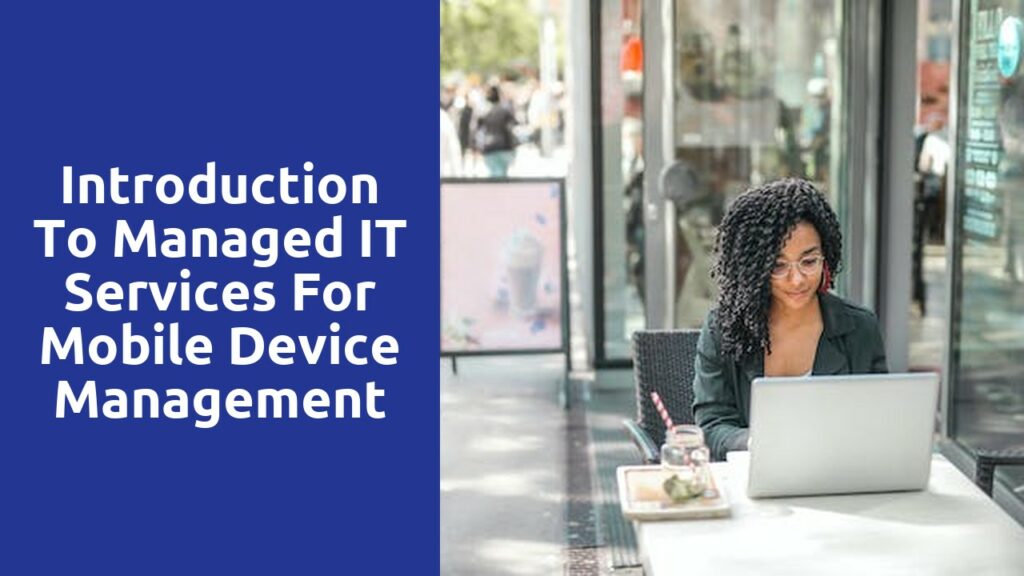What are Managed IT Services for Mobile Device Management?
Managed IT services for mobile device management (MDM) refer to the outsourcing of the management and maintenance of mobile devices within an organization. This includes smartphones, tablets, and other portable devices that employees use for work-related tasks. These services are typically provided by third-party IT companies that specialize in MDM and have the expertise to handle the complexities of managing mobile devices on a large scale.
By opting for managed IT services for MDM, businesses can offload the burden of managing mobile devices to external experts. This allows organizations to focus on their core operations while ensuring that their mobile devices are properly managed and secured. The service provider takes on responsibilities such as device configuration, software updates, security management, and troubleshooting. Additionally, they can provide proactive support and monitoring to identify and resolve any potential issues before they become major problems. This helps businesses optimize their mobile device usage and ensures that their employees have access to reliable and secure devices for their work.
Why is Mobile Device Management important for businesses?
In today’s fast-paced digital era, mobile devices have become an integral part of our lives. Whether it’s smartphones or tablets, these devices have revolutionized the way we communicate, work, and access information. For businesses, the adoption of mobile devices has brought immense productivity and flexibility. However, along with the benefits come the challenges of managing and securing these devices, which is where Mobile Device Management (MDM) plays a crucial role.
One of the key reasons MDM is important for businesses is the need for data security. With every passing day, the volume of sensitive corporate data being accessed and stored on mobile devices is increasing. From confidential client information to intellectual property, businesses cannot afford to overlook the risks associated with data breaches. MDM allows organizations to implement strict security policies, such as encryption and remote data wipe, to protect sensitive information in case a device is lost or stolen. Moreover, MDM also facilitates the establishment of secure network access and controls, ensuring that only authorized individuals can access corporate resources through their mobile devices.
Benefits of implementing Managed IT Services for Mobile Device Management
Organizations today face numerous challenges when it comes to managing mobile devices. With the exponential growth of mobile technology, it has become essential for businesses to implement effective mobile device management strategies. This is where the benefits of implementing managed IT services for mobile device management come into play.
One major advantage of utilizing managed IT services for mobile device management is enhanced security. With the increasing prevalence of cyber threats, it is crucial for organizations to safeguard sensitive data and minimize the risk of data breaches. Managed IT services can provide comprehensive security solutions, including encryption, firewall protection, and remote wiping capabilities. This ensures that mobile devices are protected from unauthorized access and that corporate data remains secure. Additionally, managed IT services can track and monitor all mobile devices, enabling organizations to identify potential security vulnerabilities and take immediate action.
Challenges faced in Mobile Device Management
Enterprises today face numerous challenges when it comes to mobile device management (MDM). One of the primary challenges is the sheer variety of devices and operating systems that employees use. With the growing popularity of bring-your-own-device (BYOD) policies, businesses must navigate a complex landscape of smartphones and tablets running on different platforms, such as iOS, Android, and Windows. This heterogeneity poses a significant challenge for IT teams as they strive to ensure compatibility, security, and optimal performance across devices.
Another major challenge in MDM is the constant evolution of mobile technologies. Every few months, new smartphones and tablets enter the market with advanced features and capabilities. While this offers exciting opportunities for businesses to enhance productivity and efficiency, it also poses challenges in terms of management and integration with existing systems. IT teams must actively stay updated with the latest devices, operating systems, and mobile management solutions to effectively handle the ever-changing mobile landscape. Failure to do so can lead to security vulnerabilities, decreased efficiency, and increased downtime.
Best practices for Mobile Device Management
Mobile device management (MDM) is crucial for organizations in today’s digital landscape. It not only ensures the security of data but also optimizes the productivity of employees. To implement an effective MDM strategy, it is essential to follow certain best practices.
Firstly, organizations should establish clear policies and guidelines regarding the acceptable use of mobile devices. This includes defining the types of devices allowed, the permitted applications, and the data accessibility levels. Clear and concise communication of these policies will minimize any confusion and ensure uniformity across the organization.
Secondly, regular monitoring and updating of mobile devices is crucial to maintain security. This includes installing security patches, updating software applications, and configuring firewalls. By keeping a close eye on the status of mobile devices, organizations can detect and mitigate any vulnerabilities before they are exploited.
Overall, implementing best practices in mobile device management is a proactive approach to mitigate security risks and enhance efficiency. By setting clear policies and regularly monitoring devices, organizations can ensure a secure and productive mobile environment. Stay tuned for the next section where we delve into the importance of employee training in MDM and the potential challenges faced in its implementation.
Key features of Managed IT Services for Mobile Device Management
Mobile Device Management (MDM) has become increasingly crucial in today’s technology-driven world. With the rise of remote work and the widespread usage of smartphones and tablets, businesses need a robust solution to manage their mobile devices efficiently. Managed IT services offer a range of key features that provide an effective MDM solution.
One of the primary features of Managed IT Services for Mobile Device Management is the ability to remotely manage and monitor devices. This feature allows IT administrators to have complete control over the mobile devices used within the organization, regardless of their location. Through remote management, administrators can perform tasks such as software updates, security patches, and data backups, ensuring that all devices within the network are up-to-date and secure. Additionally, the ability to monitor devices in real-time provides valuable insights into device usage, allowing organizations to identify potential vulnerabilities and address them promptly.
Related Links
Introduction to Managed IT Services for Mobile Device Management
Future Trends in Managed IT Services for Mobile Device Management

